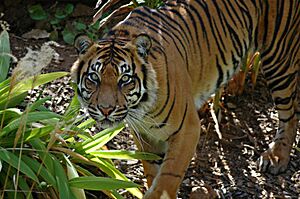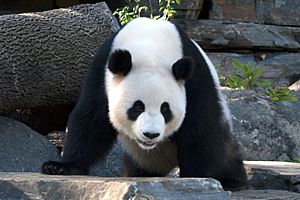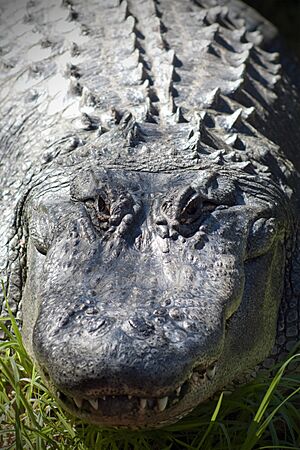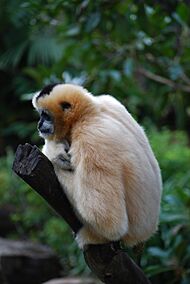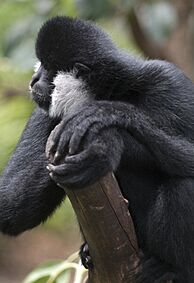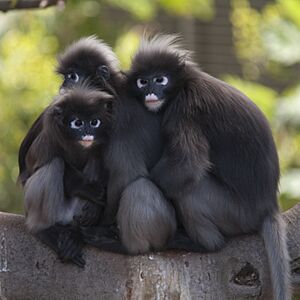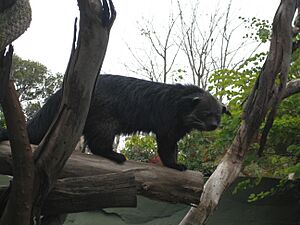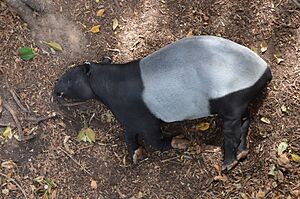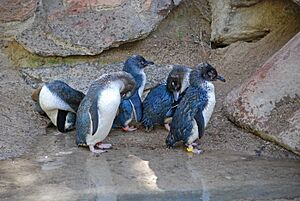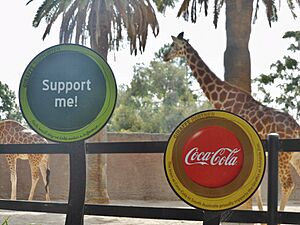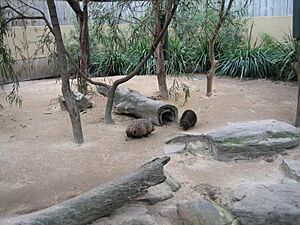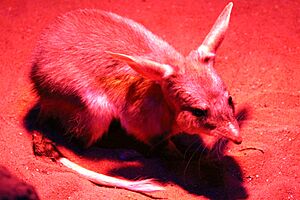Adelaide Zoo facts for kids
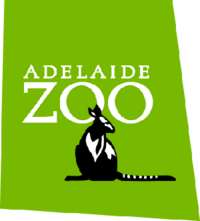 |
|
| Date opened | 23 May 1883 |
|---|---|
| Location | Adelaide, South Australia, Australia |
| Land area | 8 hectares (20 acres) |
| Coordinates | 34°54′51″S 138°36′21″E / 34.91417°S 138.60583°E |
| No. of animals | 3,000+ |
| No. of species | 300 |
| Memberships | Zoo and Aquarium Association, World Association of Zoos and Aquariums |
Adelaide Zoo is a fantastic place to visit in Adelaide, Australia. It's the second oldest zoo in the country, first opening its doors in 1883. This special zoo is run as a non-profit organization, meaning all the money it makes goes back into caring for the animals and helping conservation efforts. You can find it in the beautiful parklands, just north of the city centre. The Royal Zoological Society of South Australia manages the zoo, and they also look after the Monarto Safari Park nearby.
The zoo is home to over 3,000 animals, representing more than 250 different kinds of native Australian and exotic species from around the world. One of its most exciting areas is the "Immersion" exhibit, which is part of the South-East Asia section. Here, you can feel like you're walking right through a jungle, with amazing animals like Sumatran tigers and Sumatran orangutans seemingly close by. Several buildings at the zoo are considered important historical places, including the main entrance and the old Elephant House. Adelaide Zoo is also a botanical garden, filled with many interesting plants, both local and from other countries. One famous plant is a Moreton Bay fig tree that was planted way back in 1877!
Adelaide Zoo is famous for being the only place in the southern hemisphere where you can see giant pandas. Their special panda centre opened in December 2009. The zoo welcomed two new pandas, Xing Qiu and Yi Lan, in 2024. They replaced the previous pandas, Wang Wang and Funi, who lived at the zoo until November 2024. Xing Qiu and Yi Lan live as a pair, and you can also see a Red panda named Ravi nearby.
Contents
History of Adelaide Zoo
Adelaide Zoo first opened on May 23, 1883. The government gave the zoo 6.5 hectares of land, which has since grown to 8 hectares. It was started by a group called the South Australian Acclimatization and Zoological Society. This society later became the Royal Zoological Society of South Australia in 1937, after receiving a special honour from King George VI.
The zoo had a family of directors for many years. R. E. Minchin was the first director from 1882 to 1893. His son, A. C. Minchin, took over from 1893 to 1934, and then his grandson, R. R. L. Minchin, from 1935 to 1940. Another grandson, Alfred Keith Minchin, ran a private Koala Farm nearby. Some of the koalas from his farm were even released onto Kangaroo Island.
In the past, the zoo was involved in sending live birds overseas. However, over time, people realized how important it was to protect Australia's native birds. The zoo's management changed to focus more on animal health and safety. Today, the zoo is known for its strong commitment to science and conservation.
The modern zoo has changed a lot from how zoos used to be. Instead of keeping animals in separate pairs, they now group species together, just like they would live in the wild. The animal homes are designed to be more natural and comfortable for the animals. This also helps visitors learn more about their natural habitats. Some of the zoo's old buildings, like the Elephant House built in 1900, are still there. They are now used for educational displays instead of housing animals. The last elephant at Adelaide Zoo, Samorn, moved to Monarto in 1991.
The flamingo exhibit opened in 1885 and is one of the oldest parts of the zoo still in the same spot. In 2014, one of the oldest flamingos in the world, estimated to be 83 years old, passed away. The last flamingo at Adelaide Zoo, a Chilean flamingo that arrived in 1948, was humanely put to sleep in April 2018.
The nocturnal house, where you can see animals that are active at night, opened in 1974. The reptile house opened in 1985 and was made bigger in 1993. The giant panda exhibit and Bamboo Forest opened in 2009. This area used to be home to South American animals. The old ape area was replaced by an education centre and the Envirodome in 2008-2009.
In 2010, the main entrance of the zoo was moved from Frome Road. The beautiful old gates from 1883, which are made of colourful bricks and iron, have been kept and restored. The zoo's restaurant is in a brick building that was originally a monkey house. It was built in 1891 and later became a kiosk before being renovated into a restaurant.
Current Focus and Conservation
Adelaide Zoo focuses on animals from the ancient "Gondwana" supercontinent. This huge landmass broke apart long ago to form places like South America, India, Africa, Australia, and South East Asia. The zoo's main exhibits show how plants and animals from these regions are connected. You can explore the South East Asian Rainforest and the Australian Rainforest Wetlands walk-through aviary. For example, the South East Asian area has Malayan tapirs and dusky leaf monkeys living together in one exhibit. Other animals, like northern white-cheeked gibbons and siamangs, live on nearby rainforest islands. The zoo also helps conserve African species such as Pygmy hippopotamuses, mandrills, and eastern black-and-white colobuses.
The "Immersion" exhibit, which is all about South East Asia, was built in two stages. The first part, finished in 1995, created homes for animals like siamangs. The second part, mostly finished in late 2006, brought in Sumatran orangutans, siamangs, and Sumatran tigers. There's also a large walk-through aviary that leads visitors past the gibbon islands to the tiger areas.
Adelaide Zoo has always been known for its amazing bird collection. However, it's hard to bring many exotic birds into Australia because of strict rules. This means the zoo mostly gets exotic birds that are born in Australia or those that have been rescued from illegal imports. The same rules apply to many mammal species.
The zoo also puts a lot of effort into its educational programs. They offer tours where you can learn more about the zoo, and there's a fun "children's zoo" area. Since 2009, there's been a special educational area for high school students and teachers. Schools can even rent the facility for overnight stays, supervised by zoo staff. The Envirodome, which opened in April 2009, is another educational area. It offers night walks, tours, and opportunities for animal research. You can find more details about these programs on the zoo's website. The education building is located where the old ape grottos used to be.
The zoo continues to become more modern, creating immersive habitats that look like natural ecosystems. Plans include improving homes for African, Asian, South American, and Australian native animals. They are also expanding breeding programs for native species like the Western swamp tortoise. The zoo supports global conservation efforts, helping many endangered species around the world.
Animals You Can See
In 2023, Adelaide Zoo was home to over 2,500 animals from 250 different species. Back in 1990, there were about 1,300 animals of 282 species.
- Immersion Precinct Trail
- Dusky leaf monkey
- Hamadryas baboon
- Malayan tapir
- Mandrill
- Northern white-cheeked gibbon
- Pygmy hippopotamus
- Siamang
- Sumatran orangutan
- Sumatran tiger
- Bamboo Forest Trail
- Zoos Main Trails/Pathways
- African spurred tortoise
- African spur-thighed tortoise
- Aldabra tortoise
- American alligator
- Asian small-clawed otter
- Binturong
- Bolivian squirrel monkey
- Brazilian tapir
- Cape porcupine
- Capybara
- Dingo
- Eastern black-and-white colobus
- Fennec fox
- Giraffe
- Kangaroo Island grey kangaroo
- Komodo dragon
- Little penguin
- Maned wolf
- Meerkat
- Patagonian mara
- Quokka
- Red kangaroo
- Rhinoceros iguana
- Ring-tailed lemur
- Serval
- Short-beaked echidna
- Southern cassowary
- Southern hairy-nosed wombat
- Tammar wallaby
- Tasmanian devil
- Yellow-footed rock wallaby
- Tamarin House
- Nocturnal House
- Black-footed tree-rat
- Brush-tailed bettong
- Brush-tailed mulgara
- Common ringtail possum
- Eastern barn owl
- Fat-tailed dunnart
- Greater bilby
- Greater stick-nest rat
- Olive python
- Spinifex hopping-mouse
- Squirrel glider
- Variety Children's Zoo
- Reptile House
- Adelaide pygmy blue-tongued lizard
- Aruba Island rattlesnake
- Blood python
- Boyd's forest dragon
- Broad-headed snake
- Central netted dragon
- Centralian knob-tailed gecko
- Corn snake
- Gila monster
- Green anaconda
- Hosmer's spiny-tailed skink
- Inland taipan
- Red-bellied black snake
- Southern angle-headed dragon
- Southern death adder
- Woma python
- Jewels of Asia Aviary
- Black-capped lory
- Black-winged stilt
- Channel-billed cuckoo
- Chattering lory
- Dollarbird
- Dusky lory
- Emerald dove
- Luzon bleeding-heart dove
- Malabar parakeet
- Noisy pitta
- Palm cockatoo
- Red lory
- Rose-crowned fruit-dove
- Sacred kingfisher
- White-breasted ground dove
- South-East Asian Aviary
- Indian peafowl
- Java sparrow
- Lady Amherst's pheasant
- Mandarin duck
- Nicobar pigeon
- Plum-headed parakeet
- Birds of the Adelaide Hills Aviary
- Australian Rainforest Birds Walkthrough Aviary
- Australasian figbird
- Australian king parrot
- Buff-banded rail
- Eclectus parrot
- Pied imperial pigeon
- Regent bowerbird
- Satin bowerbird
- Superb lyrebird
- White-headed pigeon
- Wonga pigeon
- Ponds and Wetland Walkthrough Aviary
- Australian pelican
- Brolga
- Cape Barren goose
- Chestnut teal
- Glossy ibis
- Little egret
- Little pied cormorant
- Royal spoonbill
- Birds of the Australian Desert Aviary
- Other Birds
- African grey parrot
- Australian figbird
- Banded lapwing
- Barking owl
- Black lory
- Black-breasted buzzard
- Black-capped caique
- Black-necked stork
- Blue and gold macaw
- Blue-winged kookaburra
- Brown-throated conure
- Buff-banded rail
- Crested bellbird
- Crimson-bellied conure
- Diamond dove
- Elegant parrot
- Gang-gang cockatoo
- Gouldian finch
- Helmeted guineafowl
- Illiger's macaw
- Major Mitchell's cockatoo
- Nankeen kestrel
- Orange-bellied parrot
- Painted finch
- Radjah shelduck
- Red-headed parrotfinch
- Red-tailed black cockatoo
- Regent parrot
- Scarlet macaw
- Striped honeyeater
- Sun conure
- Superb fairy-wren
- Tawny frogmouth
- Wandering whistling duck
- White-bellied caique
- White-browed woodswallow
- Yellow-crowned amazon
- Yellow-naped amazon
- Yellow-tailed black cockatoo
- Zebra finch
- Envirodome
The Envirodome is an exciting, hands-on area located in the old Ape Block, along with the Education Centre. It focuses on teaching visitors about protecting our environment and how small changes can make a big difference. The building itself is very eco-friendly, using recycled materials, a green roof, rainwater-fed toilets, hay-bale walls, and solar panels. Animals you can find in the Envirodome include:
- Australian grass mantis
- Australian red-eyed tree frog
- Australian rainforest scorpion
- Australian tarantula
- Banded archerfish
- Blistered pyrgomorph
- Cane toad
- Children's stick insect
- Egyptian beetle
- Golden orb-weaver
- Goliath stick insect
- Magnificent tree frog
- Mitchell's rainforest snail
- Murray River short-neck turtle
- Northern spiny-tailed gecko
- Rainforest millipede
- Rough-scaled python
- Spiny leaf insect
- Tiger huntsman
- Veiled chameleon
- Wolf spider
Zoo Events and Animal Stories
Sometimes, unexpected things happen at the zoo! In January 1902, a keeper was injured by a brown bear because the enclosure wasn't fully secured. The bear was then safely managed. In September 1909, a snake at the zoo made headlines for swallowing a rug, which it later safely returned!
In February 1920, a keeper was sadly injured by a polar bear and passed away two days later. In 1985, a very sad event occurred when 64 animals were harmed by intruders. In 2005, a boy was injured trying to climb a fence at night.
On October 30, 2008, a very old and blind greater flamingo named "Greater" was sadly injured. "Greater," who was the last greater flamingo in Australia, passed away on January 30, 2014, at an estimated age of 83.
On Mother's Day in 2009, a female orangutan named Karta cleverly used plant material and a stick to get out of her enclosure. After a short adventure, she safely returned to her home.
On August 12, 2022, a new red panda named Ravi escaped from its enclosure. It was found two days later in a tree at the Botanic Park and safely returned to the zoo. In October 2022, the zoo investigated the deaths of seven female quokkas and two yellow-footed rock wallabies. It was believed they were affected by a toxic plant.
Famous Animals of Adelaide Zoo
The last Javan rhino in captivity was at Adelaide Zoo, though it was thought to be an Indian rhinoceros at the time. It passed away in 1907. The last American beaver in any Australian zoo passed away at Adelaide Zoo in July 2010.
Miss C, the last Hoffmann's two-toed sloth in Australia and the oldest in the world, passed away in June 2017 at 43 years old.
Wang Wang and Fu Ni, two giant pandas, lived at Adelaide Zoo from 2009 to 2024 as part of a special program to help protect endangered wildlife.
Yiray the quokka, one of Australia's threatened species at the zoo, gave birth to a baby in March 2022.
Snow White, also known as Snowy, was the world's first and only known "white meerkat." She was born at Adelaide Zoo in September 2010. By late 2012, her fur and skin started turning white, and veterinarians diagnosed her with vitiligo, a condition that causes loss of skin pigment. She and her seven brothers were later named after the characters from the Walt Disney film Snow White and the Seven Dwarfs. Snowy needed sunscreen and a shadier home to protect her skin, but her vitiligo didn't affect her quality of life much. Sadly, Snowy passed away on October 30, 2024, at the age of 14 due to age-related health issues.
See also
Images for kids


